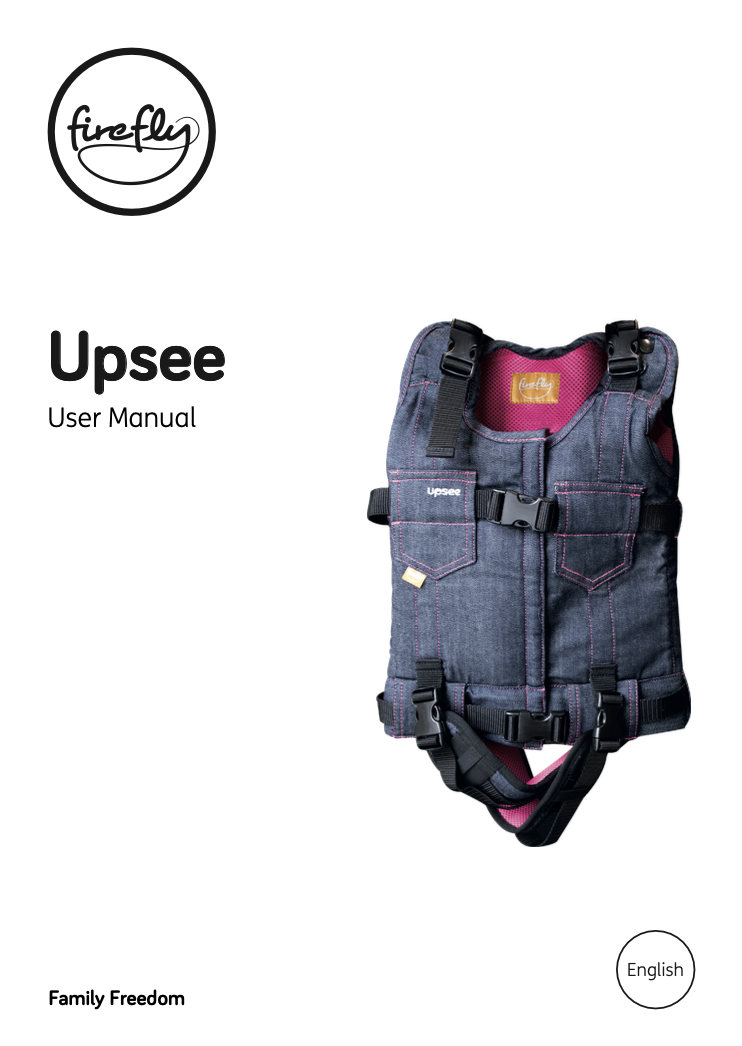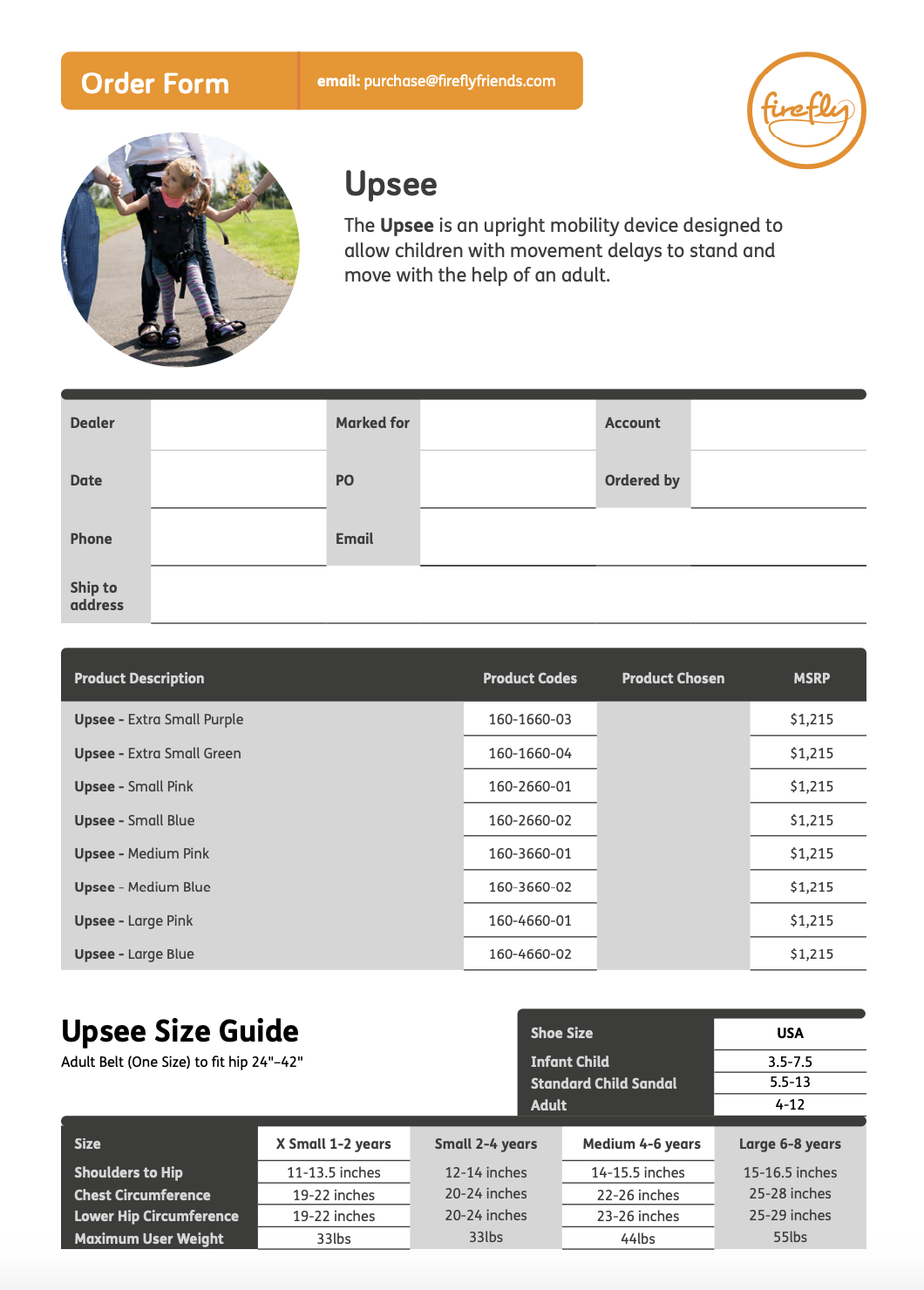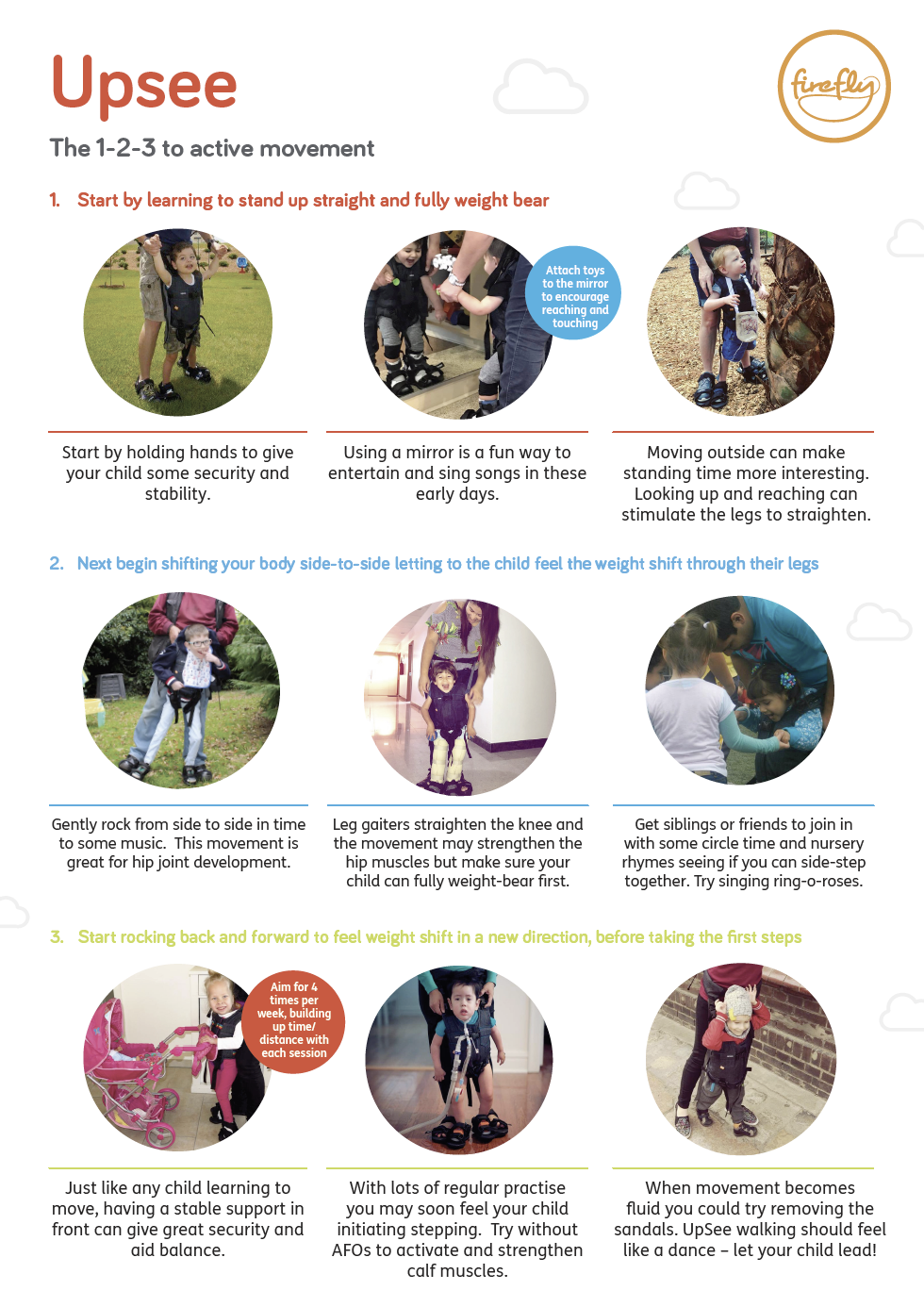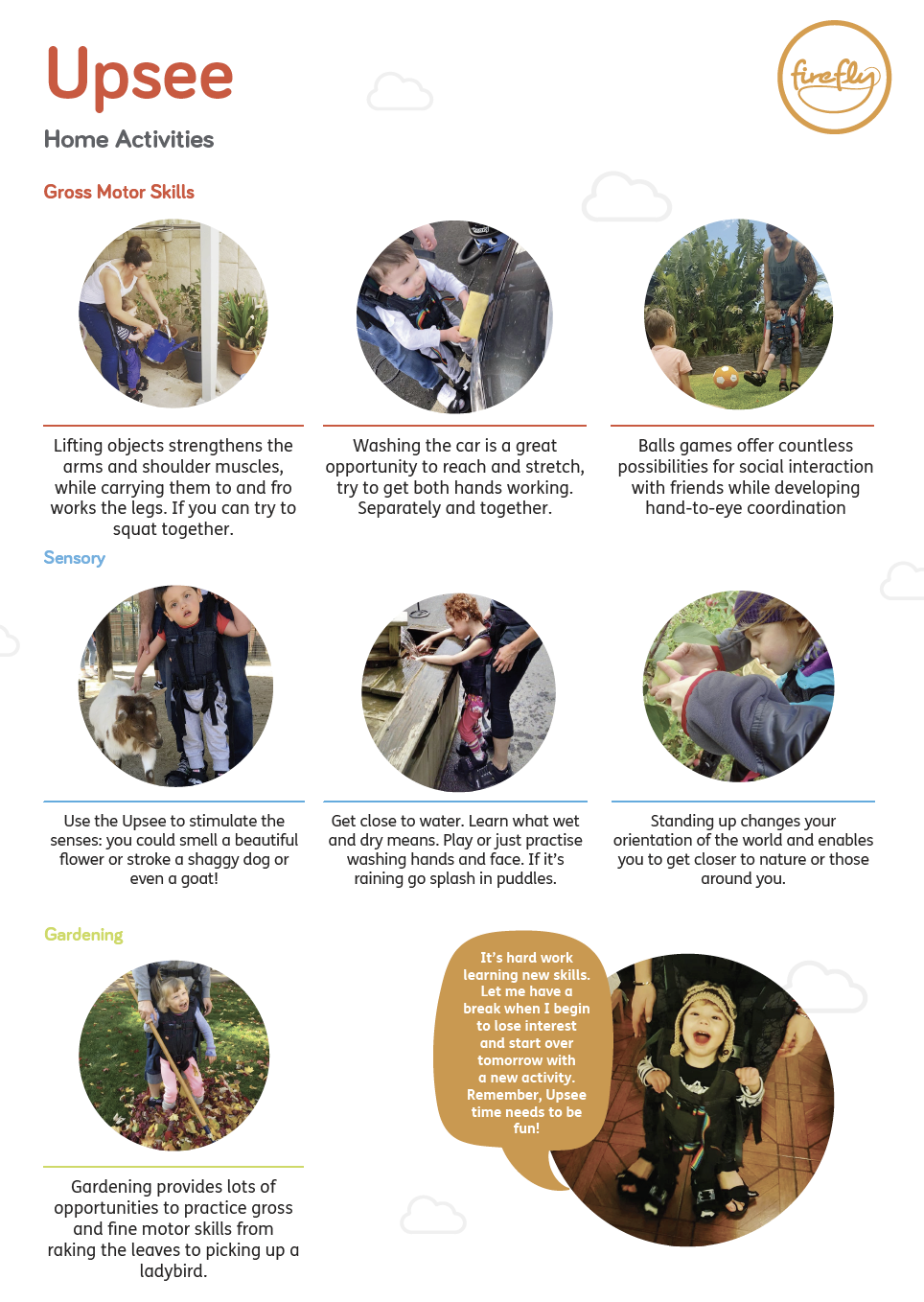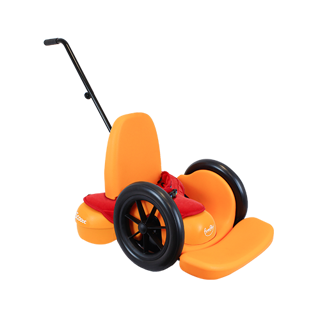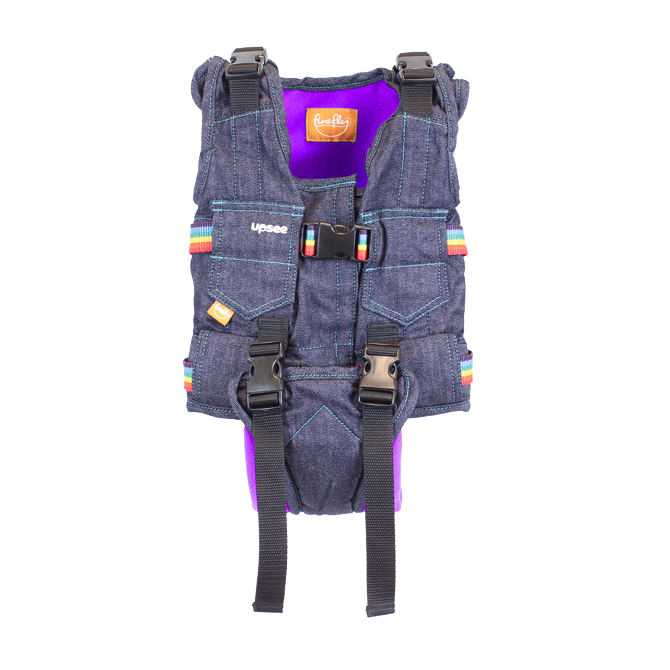
Upsee
Actividad en posición vertical, arnés de movilidad
Upsee mobility harness is designed to allow children with motor impairment to stand and move with the help of an adult - letting them experience upright movement like anyone else. Some have been able to stand and hug their little brother or sister for the first time. Some have waved at neighbors on their first ever walk along their own street. Bundle purchase available via the Accessories Page - The Upsee Therapist Kit consists of 4 harness (XS – L), 2 belts, infant and adult sandals.
-
Permite el movimiento vertical con la ayuda de un adulto para niños de 1 a 8 años (máx. 25 kg/55 lbs)
-
Incluye 3 piezas: un cinturón para adultos, un arnés para niños y sandalias compartidas. Paquete de terapeuta disponible a través de Accesorios.
-
Motiva a los niños a explorar, moverse y levantar peso
Firefly products can be funded by insurance in your State
To make this possible Firefly works closely with leading medical equipment providers, including National Seating & Mobility (NSM), and Numotion. Please click on the link below to complete the contact form and we will connect you to your local provider.
Find out more
You will receive the following items with your Upsee...
-

Child Harness
Available in 4 sizes: XS for ages 1 & 2 (Purple or Green) S, M, L for ages 3 and up (Blue or Pink)
-

Double Sandals
Infant sandal comes with the XS harness - Standard sandal is included with S, M & L harnesses
-

Adult Hip Belt
One standard size: 24”-42” (60cm-106cm) The childs harness attaches to the adult waist belt
-

Therapy Program
Step-by-step guide to maximize effectiveness. Choose activities & set goals for your child's therapy
Family Freedom
-

"Long journeys have always been challenging. When we stop to ‘stretch our legs’ there's never a way for Lola to burn off energy. But today, using the Upsee, Lola could play on the playground, go for walks and make new friends. With both our arms and hands now free, we have much more independence when she’s walking."
Lola, UK -

"Today, Ivy walked across the Spinnaker Tower Sky Walk. In the Upsee, she was able to join her sister and cousins, walking and dancing over the glass."
Ivy, UK -

"Thank you Firefly for the Upsee so we can play baseball and run bases like others!"
Ellie, US
| Size Guide | X Pequeño | Pequeño | Medio | Grande |
|---|---|---|---|---|
| Edad [aprox. años] | 1 - 2 | 2 - 4 | 4 - 6 | 6 - 8 |
| Hombros a cadera [pulg./cm] | 11-13.5 / 28-32 | 12-14 / 31-36 | 14-15.5 / 35-39 | 15-16.5 / 38-42 |
| Circunferencia torácica [pulg. / cm] | 19-22 / 50-57 | 20-24 / 52-60 | 22-26 / 57-65 | 25-28 / 63-71 |
| Circunferencia inferior de la cadera [pulg. / cm] | 19-22 / 50-57 | 20-24 / 52-60 | 23-26 / 58-67 | 25-29 / 64-73 |
| Peso máximo del usuario [kgs / lbs] | 15 / 33 | 15 / 33 | 20 / 44 | 25 / 55 |
Mesa giratoria
The Benefits of Upsee
-

Participation & Inclusion
Making play & participation possible right now, creating the possibility of social & emotional development, and letting children interact with peers at eye-level.
-

Build Important Skills
Upsee can be used to work on a variety of mobility and ability skills, from weight-bearing and walking to improving head control.
-

Motivation & Development
When your child is motivated to explore and move and weight-bear, it creates a real possibility for long-term development.
-

Opportunities
Leading therapists endorse Upsee because it creates so many possibilities. It can be used for fun and play around the home or with your child's therapist during therapy sessions.
Upsee Resources
Upsee FAQs
-
What are the benefits of the Upsee over other mobility aids?
While it depends on the ability of your child, the Upsee can offer a number of advantages over other mobility aids. It provides the possibility of weight bearing through lower limbs which can change according to the abilities of your child. The Upsee enables active assisted movement so your child can stand and step to the best of their ability with the minimum level of assistance provided by you. Because you can feel your child’s stepping movements through the double sandal, Upsee enables you to provide assistance to step as required. Upsee provides the possibility of cruising (moving sideways along furniture)
The type of support provided by the Upsee means that the child’s hands are free to play, while giving the child the potential to achieve hip abduction (legs apart) and actively work trunk muscles in standing. Encouraging play through use of Upsee will make the child more motivated to use the product. In addition to the clinical and developmental opportunities, the Upsee is lightweight and portable. It allows parents to help their child to experience standing, stepping and to fulfil their physical potential through family participation.
-
Is using the Upsee therapy, play or sport?
The Upsee is potentially all three! Children may gain the therapeutic benefits of supported standing and stepping while they play and participate in sports and family activities. See the User Instructions and Upsee Therapy Program for more ideas about to how to use the Upsee indoors and outdoors.
-
Should my child wear splints/ braces while using the Upsee?
Yes, if they usually wear them for weight-bearing activities. If you’re not sure, check which splints are being used during physical therapy sessions. For lower limbs, ankle splints (AFOs) may help to address the problem of knees locking back into hyperextension. If knees are still locked back when wearing ankle splints, try standing facing down a very gentle slope while using the Upsee. This should encourage knee bending (flexion). In addition, lower limb gaiters may help keep knees straight. For upper limbs – arm gaiters may assist in keeping elbows straight and enable your child to hold the handle of a push-along wheeled toy.
-
Is the Upsee a replacement for physical therapy?
The Upsee is an addition to physical therapy. It is important that your child continues with their physical therapy routine. We recommend that you inform your child’s physical therapist that you are using the Upsee. You may also wish to seek advice prior to purchasing the Upsee from your child’s therapist.
-
I feel unsteady using the Upsee – help!
Check the height of the child compared to the adult using the Upsee within safe limits the child’s shoulders should not be higher than the adult’s navel. Check that the adult’s stomach does not push the child too far forward so that they are unable to stand up straight. If so, the Upsee is not suitable for use by this adult.
Begin using Upsee in a familiar environment for short periods of time and build up confidence with experience. Stand with your feet wider apart, take wider steps than you would normally, and have someone else present, or use your hallway or an environment where there is a wall for you to get additional support from if you need it. Take your time and do not rush. If you feel you are unable to become steady, we recommend that you STOP using the Upsee.
-
Can an older child use the Upsee with their younger brother or sister?
This device is designed for use with an adult or children over the age of 16 years, as long as the child’s shoulders are still below the older child’s belly button. Younger children are still developing therefore using the Upsee may be harmful to their growing bones and muscles.
Older children have an important role in motivating their little brothers or sisters to enjoy action games, dancing, ball games, joint tabletop play etc.
-
Can we use the Upsee on steps or stairs?
The use of the Upsee on steps or stairs would pose significant safety issues and is not advised.
However, allowing the child to stand with alternate feet on a low step can help to develop muscle activity (co-contraction) around the trunk and pelvis – this is called step standing and is useful for children with low tone to work towards improved hip and trunk stability. If the child presents with asymmetry in standing, you can try step standing by placing the stronger leg on a step and then following with the weaker leg. Repeat this process to come back down the step. This will encourage an element of weight bearing through the weaker leg.
-
My child becomes overly excited when using the Upsee. Is that ok?
Yes! It is ok for your child, but you need to be careful that any unpredictable movements by them do not cause you to lose your balance. If your child is very excited and active, start using the Upsee in standing only, before you progress to walking where you have a wall, couch, or handrail for support.
When your child becomes calm and adjusted to the Upsee, try walking together, pushing a wheeled toy, or moving to the beat of music or a song.
-
My child is fearful of standing. Can the Upsee help?
If your child is fearful of being upright or walking, ensure they feel secure as possible by standing at the sofa and using the Upsee in a familiar environment to begin with. Keep your child in close contact with you for a feeling of security and use distractions like playing favorite games with brothers or sisters or watching a favorite TV program. You can progress to a wider range of activities as your child gains confidence.
-
How long should I use the Upsee for in each session?
When you first use the Upsee, stand for about 2 – 5 minutes depending on your child’s weight bearing ability. Keep your initial sessions short. If your child is happy in the Upsee, he/she will be more likely to accept this new experience of standing and stepping. You can increase the amount of time in the Upsee as your child starts to enjoy being in it and you become more comfortable. Remember to stop using the Upsee if you or your child experience any discomfort. You can find further information on how to grade the activity and length of time your child spends in the Upsee using the MAP assessment in the Upsee Therapy Program.
-
How many times per week should I use the Upsee?
This depends on what you wish to achieve. If your goal for your child is just to experience assisted standing and stepping, then the Upsee can be used as frequently as your child enjoys these alternative positions.
If your child has the potential to develop standing and stepping skills while using the Upsee, then a daily routine using the Upsee may be helpful. Refer to the Upsee Therapy Program for further guidance on this.
-
How do I know how tight to pull the connecting straps?
In order to allow your child to be as active as possible in weight bearing activities while ensuring the safety of you both, there is a “fine tuning” process that you must go through together. We suggest the following guidelines for the “fine tuning” of the hip and shoulder straps:
Pelvic connectors (grey straps):
- The pelvic straps should be tightened only as much as is necessary to keep the child’s pelvis at its highest level while allowing the child to bear the majority of his/her own weight. You are not intended to bear the child’s weight through the connecting straps.
- To find the right tension, you may need to loosen and tighten these straps a bit while looking down at your child’s pelvic position or by using a mirror. After you start walking you may have to readjust the connecting straps again as there is a settling in of the harness and straps that occurs over the first few minutes of walking.
Shoulder connectors (black straps):
- The shoulder straps are intended to support the child’s trunk to ensure that it does not sway forwards/backwards or from side to side. The shoulder straps are not intended to bear the child’s weight as in a suspension harness.
- “Tuning” the shoulder straps demands tightening and lengthening these straps until you find the right level of support where the trunk is supported without suspending the child from their shoulders. After you start walking you may have to readjust again as there is a settling in of the harness and straps that occurs over the first few minutes of walking.
-
What activities should we do in the Upsee?
The Upsee therapy program provides a step-by-step guide on how to choose activities specific to your child’s development.
-
My child’s upper body is leaning forward. Why?
If your child is leaning forward, something is not adjusted properly. There are four possibilities:
- The shoulder straps need “fine tuning“ see section 9.2 of the user manual.
- The harness is not fitted snugly around the child’s trunk. Pay particular attention to the pelvic strap (lower one on the harness).
- The child’s feet are not securely held within the sandals - tighten the straps.
- You are not matched well to enjoy the Upsee with your child. Either your stomach is pushing the child forward or the child’s shoulders are above your navel so that the child’s shoulder cannot be supported well from your hip belt. In either case, you will not be able to use the Upsee with your child. You have the option of finding another suitable adult to enjoy the Upsee with your child.
-
My child just ‘hangs’ in the Upsee. What should I do?
This shows that your child is not bearing weight through their legs. There may be several reasons for this:
- Firstly, check the fitting of the Upsee at the harness fastenings, and leg and connecting straps to ensure there is enough support to hold your child’s legs in an almost straight position. The straps need to be sufficiently secure to support your child’s trunk in an upright position, but not so much that the child is suspended.
- Your child is tired. Take them out of the Upsee to rest.
- Your child is not yet able to bear weight through their legs.
- Your child is capable of weight bearing but is not motivated at the moment.
It is important to search for a suitable activity that will help stimulate your child to be active, when using the Upsee.
-
My child does not want to walk in the Upsee. What should I do?
Check that your child is comfortable and adjust the Upsee if necessary. Discontinue use if he/she continues to show any signs of discomfort. Try using the Upsee only for standing to play in a familiar environment and ensure the activities available while using the Upsee are enjoyable e.g., favorite toys, musical games, friends/siblings. Go at your child’s pace and do not force him/her to move in the Upsee. Leave it for a while and try again – they will get the hang of it eventually.
-
Will the Upsee draw unwanted attention to my child’s disability?
This is a very sensitive question, and one which is difficult to answer. The parents we have worked with have found that the harness looks like a cool waistcoat, and the double sandal is unobtrusive, so it is not immediately obvious that their child is using the Upsee. However, the more important thing for them has been the opportunities for family participation which they feel far outweighs everything else. While using the Upsee may draw attention, it is for a positive and encouraging reason. Nonetheless, if you are uncomfortable with this, the Upsee can be used equally successfully within the privacy of your own home or garden/backyard.
-
I hope that my child achieves independent standing. Will using the Upsee help?
Upsee has the potential to enable your child to progress in his/her standing abilities. If your child has potential to progress, the Upsee provides the opportunity to attempt weight bearing through their legs and to initiate stepping. A child with little ability to bear weight through their legs can still experience standing in the Upsee. However, to help with the standing position it may be beneficial to go back and practice the building blocks that lead up to these more difficult positions, such as kneeling and crawling.
Every child’s potential is different, which makes it difficult to predict what they may achieve. Your child’s progress can be monitored using the MAP assessment (in the Upsee Therapy Program), which will help you decide what stage your child is currently at and what they can work towards.
-
How can my child make any progress using the Upsee?
Generally, progress may be achieved when a child becomes more actively involved in the activity of standing and/or walking. It is important that if your child starts to initiate weight bearing and/or stepping, you allow them to use their own ability by adjusting the level of support given by the Upsee and also allow them to take the lead with stepping.
Take care not to make the connecting straps too loose – this will may allow your child to sway in the Upsee, which could make you unstable. The amount of progress will vary from child to child – some going much faster than others. It is very important to remember that all children will benefit from the experience of dynamic standing with their parent, and that this may be your child’s maximum potential at this stage in their development.
-
My child does not initiate stepping. Can using the Upsee help?
The Upsee provides an opportunity for your child to step passively and gain experience moving. For some children this is a worthwhile goal by itself, while other children may have the potential to develop active weight bearing through their legs and achieve stepping.
While standing, shift your weight slightly from side to side and forward and backwards, taking care not to lose your balance. When your child is weight bearing through one leg, you can move their body weight forwards over the weight bearing foot. This will encourage and teach initiation of stepping with the unloaded foot. Remember to be sensitive to your child’s own activity and use motivational play/music/siblings to encourage the movement you want.
-
My child has quite high muscle tone in his legs. Can he use the Upsee?
The Upsee should not be used for children with very high abnormal muscle tone in cases where their legs are rigid or very resistant to movement. If your child has mild or moderate increased tone and their ankle, knee and hip joints can be moved through the ranges of movement used during walking, then the Upsee may be suitable for them. Standing and swaying from side to side or forwards and backwards in step standing may help to reduce the increased muscle tone in your child’s legs in preparation for stepping.
-
My child is asymmetrical. Can he use the Upsee?
A child with any degree of asymmetry may benefit from use of the Upsee provided the level of abnormal muscle tone along their more affected side is not rigid or very resistant to movement. The more affected side also needs to have sufficient range of movement in the leg to achieve a standing position. Once in the standing position, sideways shift over the more affected side may achieve elongation of that side and subsequent reduction in muscle tone. As for a child with generalized high muscle tone, swaying from side to side in standing may help to reduce abnormal muscle tone.
If your child has a small leg length difference, they should still be able to use the Upsee effectively with ordinary shoes. However, we recommend that you check with your therapist, and if they normally wear a shoe raise for other standing or walking activities, they should do so while using the Upsee.
-
My child has reduced head control. Can they use the Upsee?
Using the Upsee gives your child potential to develop head control because the standing position facilitates active neck extension and head lift. Try to move your child’s shoulders back slightly to encourage further head lift.
From the standing position, encourage your child to lift their head by using play to motivate upward eye tracking and subsequent head lift. You can help to facilitate head lift by either lifting the child’s arms up to play or rest on a surface at shoulder height. You might also try placing the child’s hands, palms flat, with straight elbows, against a large mirror at shoulder height, so that they can see themselves.
If your child is not able to lift their head following the suggestions above it may be helpful to lift your child’s head to enable them to see around themselves while standing in the Upsee. Try to support your child’s head with one hand on the top of their head and the other supporting at their chin to achieve a long straight neck rather than overextending their neck.
-
My child has a visual impairment. Can he use the Upsee?
Yes. The Upsee provides a safe way to stand and step for a child with visual impairment. Your close connection to your child gives him a feeling of safety and security. As you guide your child safely in stepping, with yours and his hands free to explore your environment together, you enhance the development of your child’s sensory and perceptual awareness.
-
How do I know if the upsee is suitable for my child?
Before attempting to use the Upsee for therapy or family participation activities, you must be able to answer yes to ALL THREE questions below:
- Does your child already use a standing or walking frame? (Is your child already in a standing or walking program?)
- When standing, are your child’s shoulders below your navel/bellybutton? (Your child’s height in relation to you is important for safety).
- Can you and your child both stand upright while using the Upsee? (Make sure your body shape does not alter your child’s posture).
















